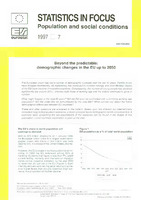| dc.contributor.author | Eurostat |
| dc.date.accessioned | 2020-09-29T08:57:17Z |
| dc.date.available | 2020-09-29T08:57:17Z |
| dc.date.issued | 1997 |
| dc.identifier.uri | https://ketlib.lib.unipi.gr/xmlui/handle/ket/2882 |
| dc.description | 1997.7 |
| dc.description | Downloaded from EU Bookshop. |
| dc.description | http://aei.pitt.edu/id/eprint/85142 |
| dc.description.abstract | The European Union has had a number of demographic surprises over the last 30 years. Fertility levels have dropped dramatically, life expectancy has continued to increase strongly and most Member States of the EU have become immigration countries. Consequently, the number of young people has declined significantly (by around 20%), whereas both those of working age and the elderly continued to grow in number. What might happen in the next 50 years? Will the EU soon be confronted with a shrinking working age population? Will the under-20s be outnumbered by the over-60s? What can we say about the future demographic differences between EU countries ? These and other questions are answered in this bulletin. Based upon five different but internationally consistent long-term population scenarios, a dozen principal future demographic trends are presented. A summary table concerning the key-assumptions of the scenarios can be found in the middle of this publication; a brief technical explanation is given at the end |
| dc.format.extent | 12p. |
| dc.language.iso | en |
| dc.publisher | Statistical Office of the European Communities and Social Statistics |
| dc.subject | Social Policy |
| dc.subject | Demographic Statistics |
| dc.title | Statistics in Focus: Population and social conditions. Beyond the predictable: demographic changes in the EU up to 2050. |
| dc.type | working document |
| dc.publisher.place | Luxembourg |

